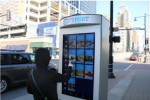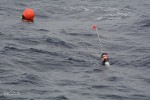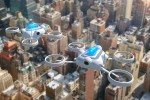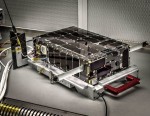
Thursday, September 15th, 2016
Washington, DC — At seven feet tall and featuring 55-inch screens, the 30 kiosks coming to downtown D.C. will be much more than glorified digital ad machines. Designed by New York–based Smart City Media, the kiosks will feature timely information relating to nearby restaurants, retail, events, and public transportation. This pilot program is led by

Wednesday, September 14th, 2016
Using a new system of drifting buoys, scientists from NOAA’s Southwest Fisheries Science Center in La Jolla, Calif., will have a much better chance of hearing beaked whales in their deep-water habitat off the West Coast. About 20 buoys will be deployed from a NOAA ship with a listening device suspended 330 feet below the

Thursday, September 8th, 2016
The National Geospatial-Intelligence Agency (NGA) and the National Science Foundation (NSF) released new 3-D topographic maps of Alaska on Sept. 1, 2016, in support of a White House Arctic initiative to inform better decision-making in the area. The 3-D digital elevation models (DEMs) are the first to come from the ArcticDEM project, which was created

Thursday, September 1st, 2016
A SpaceX rocket exploded at its Cape Canaveral launch pad Thursday morning, destroying the rocket and the satellite it was due to launch on Saturday. SpaceX said there were no injuries as a result of the explosion, which it described as an “anomaly.” SpaceX CEO Elon Musk tweeted that the explosion happened while the rocket

Thursday, September 1st, 2016
Disasters and emergencies can happen at any time, often without warning. Natural hazards threaten thousands of lives and cause billions of dollars in damage every year throughout the nation. September is National Preparedness Month, a time to highlight the resources available to help you and your loved ones stay as safe as possible. This article

Tuesday, August 30th, 2016
A 6.2 magnitude earthquake struck central Italy on Aug. 24, 2016. Approximately 300 people died as a result of the quake, which devastated several towns in the country’s Apennine mountain belt. The Italian peninsula features fault lines created by the separation of the African and Eurasian tectonic plates. The fault line separating these two plates

Tuesday, August 23rd, 2016
The National League of Cities (NLC) released Cities and Drones, a new report that provides cities with insight on the recently released Federal Aviation Administration (FAA) rules relating to drone operation. The report also provides suggestions for how local governments can craft their own drone ordinances to encourage innovation while protecting their cities. In addition

Tuesday, August 16th, 2016
Construction of NASA’s Dellingr CubeSat is complete, and the satellite now is ready for environmental testing. Named for the god of dawn in Norse mythology, Dellingr will study the ionosphere—the outer region of Earth’s atmosphere populated by charged particles ionized by incoming solar radiation and magnetospheric particle precipitation. Slightly larger than a cereal box, Dellingr

Tuesday, August 9th, 2016
The pioneering Aladin sensor, a spaceborne LiDAR instrument with two powerful lasers, a large telescope and very sensitive receivers, is ready to join its Aeolus satellite for launch in 2017. Designed by Airbus Defence and Space, Aladin’s laser generates ultraviolet light beamed toward Earth, which bounces off air molecules and small particles such as dust,

Tuesday, August 2nd, 2016
NASA scientists and engineers are field testing the CO2 Sounder LiDAR, an instrument powerful and accurate enough to gather around-the-clock global atmospheric carbon-dioxide (CO2) measurements from space. The instrument is a strong contender for a potential next-generation carbon-monitoring mission, the Active Sensing of CO2 Emissions over Nights, Days and Seasons (ASCENDS). The LiDAR operates by